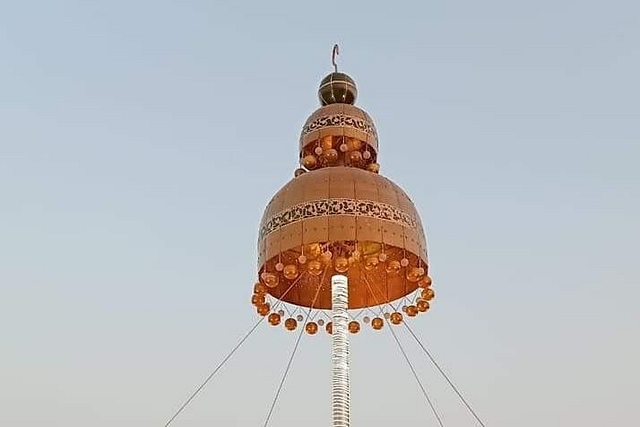
Mystery Solved: Bareilly Reclaims The Lost ‘Jhumka’ And Dedicates It To Public Art
Bareilly has discovered a piece of public art that is pleasing, attractive and makes a pitch for local crafts. In a witty and attractive take on Bareilly's association with the jhumka, an ornament worn in the ear by women, and celebrated in a Bollywood song decades ago, a depiction made of brass has been displayed there on the Lucknow-Delhi highway.
The installation made of brass, has been decorated with stones and zari (brocade work) and weighs 272 kilos according to this report. Rajesh Pandey, Deputy Inspector General (DIG) of Bareilly Range told the media that a proposal for installing the jhumka depiction was made by Bareilly Development Authority "but it got stuck in red tape”.
The installation could become possible after the intervention of Santosh Gangwar, who is Bharatiya Janata Party Member of Parliament from Bareilly.
The mention of "jhumka" goes back to a song "jhumka gira re" from the film Mera saya. The catchy song mentions the falling of one piece during a romantic meeting between a man and woman in a Bareilly baazaar.
Interestingly, the installation shows one piece instead of the regular two in a pair. It's a creative take on depicting and completing the "lost and found" theme and the story in the song.
The song has been part of popular culture, has been a material for remakes and is a staple at wedding celebrations in North India even today. Though the popularity of the trinket as mentioned in the Hindi song cannot be denied in Bareilly's context, the place used to be known for its association with "baans" — bamboo.
There is a popular idiom "Ulte baans Bareilly" which borrows from this association. Bamboo, too, can be a thing of public art for a theme as it would go with the crafts and textile rich state of Uttar Pradesh and a revival of another element.
But it seems it lost to the jhumka in terms of popularity and appeal.
Pandey told the Indian Express:
Once I was looking at our Gazetteer along with the police commissioner, we found that there were two districts in the united province during the British rule — Bareilly and Rae Bareli. And Britishers, as well as common public, used to get confused between the two. To avoid confusion, people started calling Bareilly as “Baans Bareilly” for its rich production of bamboo.
Bareilly MP and local administration and citizens deserve credit for taking an initiative towards public art. While many may find it 'tacky' by the contemporary definition of a public art installation, it goes on to show that craftspersons and local crafts can add a dash of cheer and texture to humour and replace the cynical, dull and drab installations that are forced upon Indian streets by politically correct city administration.
The installation was prepared in Moradabad, which is known for brassware and related crafts.